Emergency and taxing franching covers
War events caused a big distribution troubles for stamps on Italian Social Republic territory. The stamps failure suggests at senders to affranchise their mail with several kind of stamps like postage due, parcel post or postage revenues . These types of franching were, usually, tolerated but, in some cases, they were taxed.
The four covers above showed are affranchised with parcel post stamps belonged at former Reign. Some provincial mail establishments issued circulars that allowed this kind of postage.Their esteem is usually dependent of some factors, like number of stamps on cover or their facial value.
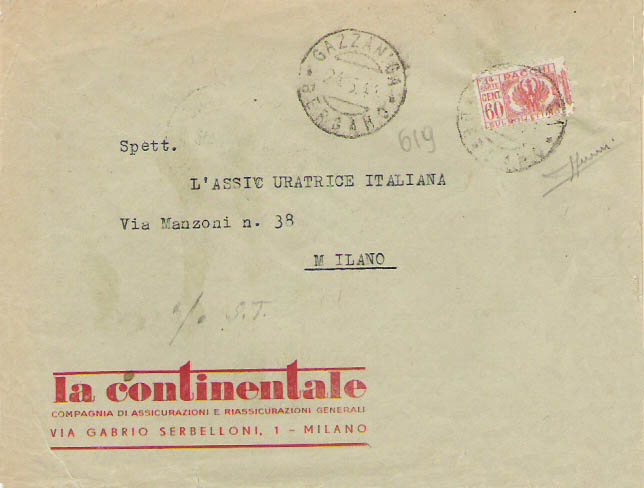
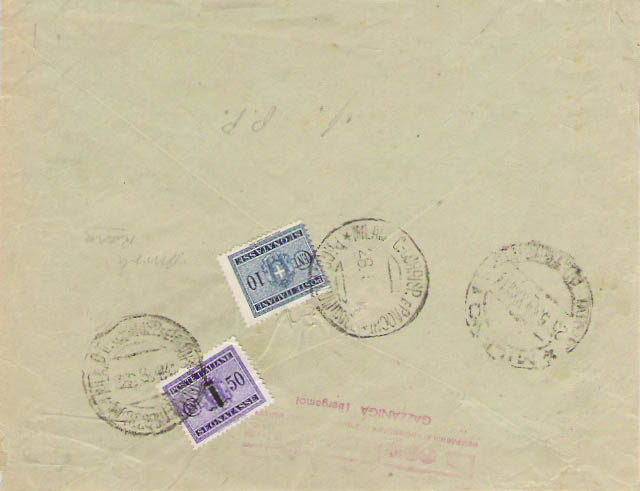
This cover is very scarce. On front there is an half parcel post stamp of 60 cent. This type of franking didn't considered valid because the double section of these stamps allowed to affranchise two covers, simply splitting It.This cover was taxed on rear with two postage due stamps, a 50 cent overprinted with fasces and a 10 cent without overprint.
Some parcel post stamps were used like postage due. The lack of stamps in some zones and for some periods, originated the usage of several types of stamps to tax covers and envelopes. The pictures above shows a cover taxed by a 50 cent. parcel post.
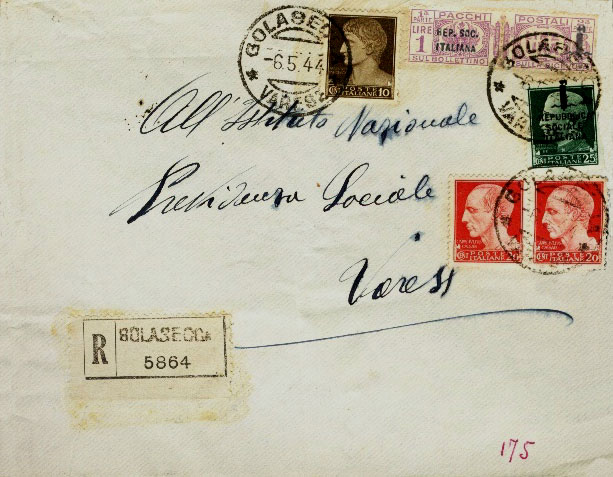
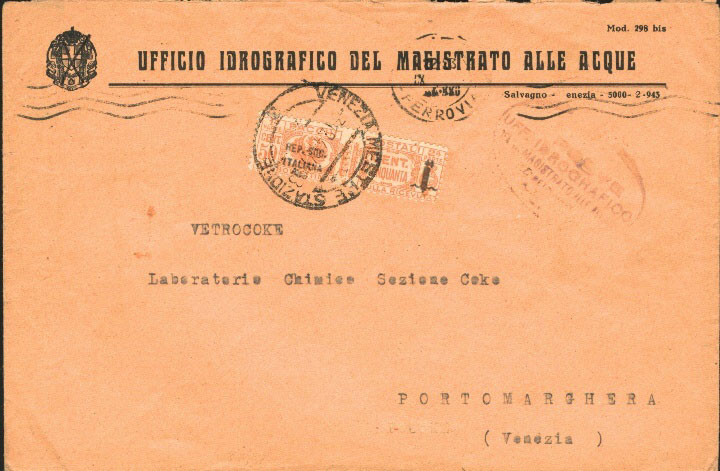
A position of privilege is up to the parcel post stamps overprinted by fasces. The two scarce covers above showed, are an obvious testimony.
More interesting are the frankings carried out by postage revenues. The incomes of the sale of postage revenues, were embedded by revenue cashes of Ministry of Finances instead of Ministry of Communications so, these covers, were usually taxed. The Post Offices received, in fact, rigorous dispositions that imposed them the taxation of corrispondence in case of franking carried out with this type of stamps. However, also in this case, some Provincial Directions, in exception to established how much of the Ministry, tolerated theirs use. The picture above shows three examples not taxed.
An other way in order to resolve the problem of the deficiency of stamps, consisted in going personally in the Post office and to deliver the object that would have had to be sent. After the payment, the cover was stamped with a special oval postmark ( R.P. PAGATO). The envelope therefore was forwarded to the adressee. Above it is visible one of these letters with the payment postmark.
A disposition of the Ministry of the Communications allowed, to the sender that sent from one stamps lacking zone, to affix the written " ZONA SPROVVISTA DI FRANCOBOLLI " (unprovided stamps zone). In these cases, the collection tax was normal instead double . In particular conditions of chronic absence of stamps or finding itself of forehead to great letter amounts to send, there was who was organized in the use of special postamarks that signaled the impossibility to affranchise covers with stamps. The envelope above visible, is a meaningful case. The letter was, in fact taxed, but for the lack of indications on the charge mail to demand, the absence of postage due and for the fact that the cover was addressed to an authority that enjoyed of a reduction of the tax, we can suppose that the payment of the shipment never did not carried out.
A lot interesting the taxation of the 2 envelopes above showed. Such letters, coming from from the Ministry of the Corporative Economy and from that one of the Industrial Production, were taxed to the arrival with the stamp of 1 Lira of the II° set called "Destroyed Monuments". The stamps were overprinted with a T (taxed).
Decidedly
valuable the two envelopes represented over. These covers were taxed to the
arrival with ordinary and parcel post stamps. Due the absence of Postage due,
the Bologna's post office used a special postmark (SPORTELLO TASSATE) to identify
that the tax was paied from the addressee.
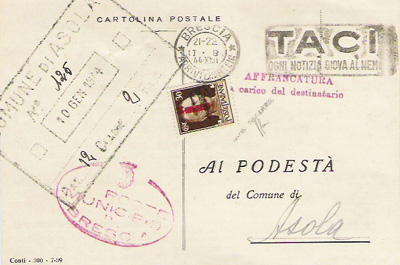
This taxed card is decidedly very interesting. It was taxed using a 30 cent. fascetto like a postage due stamp. To supply at the failure of Postage due stamps, the Postal office workers, indeed, used also ordinary stamps to tax. The fascetto on this card was cancelled by a T, to identify the use like a postage due stamp.
This envelope was sent from Cernusco sul Naviglio ( Milan ) on March, 25 1944 and addressed to Castiglione delle Stiviere ( Mantua ). The cover was under-affranchised and consequently It was taxed with a rare 50 cent. Postage due with G.N.R overprint issued in Brescia.
Another prestigious example of taxed cover is showed on this envelope who was sent on July, 29 1944 from Milan to Casalvolone ( Novara ). At first It was not affranchised ( note the wavy rows under the stamps ). The Postage due stamps with fascetto overprint were applied by the arrival Post Office and cancelled with Casalvolone mark.
Very interesting is the taxation showed on the envelopes above. In both cases the taxation was drawed using two 50 cent. fascetto, on the cover at left, and a 30 cent fascetto plus a 50 cent. of the " Destroyed Monuments " set, on the cover at right. All, the ordinary stamps used for this taxation, were overprinted with a T, obtained by a rubber mark.
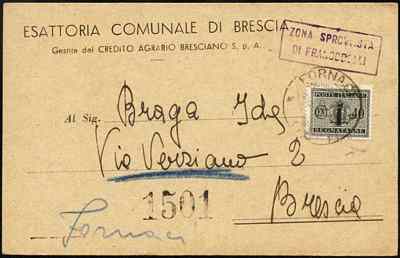
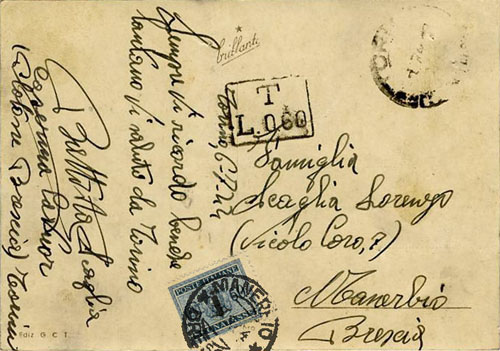
Rarer than the previous one is the postcard over visible. The post card was sent from Turin to Manerbio (Brescia), without normal franking, the document was taxed in reason of the double of rate, that is 60 cent. A taxation of this type, with 60 cent- postage due - Fascetto, represents one of the most rarity in the context of the frankings of the RSI.
![]()